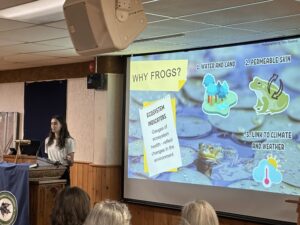Every year, Nature Counts brings us together to celebrate the dedication and hard work of our volunteers and to reflect on the impact of our conservation efforts. This year, we shared some incredible highlights from our Community Science monitoring programs, successes in species conservation, and the vital role volunteers play in protecting our natural world.
Nature Reserves with Stewardship Volunteers: 35
31 of those had more than 2 projects happening
This year’s presentation included a focus on protecting species at risk by not sharing species locations. Many species at risk are at risk of poaching, persecuted or ‘loved to death’ (disturbed).
________________________________________
Species at Risk Monitoring
- 28 Species at Risk Identified This Year: Through our collective efforts, we reported sightings of 28 at-risk species in 2024.
- 43 Unique Species Identified Since 2015: Over the years, our programs have uncovered an impressive diversity of at-risk species, shaping our conservation priorities.
- Critical Habitat Mapping: By documenting the species, locations, and conditions they inhabit, we continue to build essential maps that guide survival strategies for these species.
- Obscuring Locations: It is critical for the protection of all species at some level of risk that The Conservancy doesn’t release location information
________________________________________
 Reptile Monitoring Successes
Reptile Monitoring Successes
Since 2018, our reptile monitoring programs have evolved, leading to impactful changes.
- Snake Surveys: For three years, we have focused on long-term snake monitoring protocols from Ontario Nature.
- 24 visits, 576 board checks, with snakes observed in 2.4% of visits.
- Targeted Species Surveys: Based on past data we have changed our survey method to targeted species surveys. This has refined our understanding of species present on priority nature reserves.
- The Challenge of Road Mortality: Habitat fragmentation due to remains a significant threat to many species. Your observations help identify critical areas for mitigation efforts.
________________________________________
Frog Monitoring: A Climate Indicator
Frog monitoring, one of our longest-running programs at seven years, continues to provide vital data on environmental changes.
- Phenology Studies: By examining the timing of frog calls, we’re tracking climate impacts.
- More frogs were recorded in March this year, reflecting earlier breeding due to erratic temperature patterns.
- Twice as many thaw days were observed this year compared to previous years, and 2024 had one of the rainiest Aprils in eight years.
________________________________________
 Wildlife on Roads
Wildlife on Roads
Habitat connectivity is crucial for species survival. Monitoring the impact of roads on wildlife, particularly at sites like Monck Road, remains a priority. These efforts have helped us build a case with municipalities to support the upgrade of a culvert at Whitney Wetland Nature Reserve, to make a safer passage for many species. Work is underway now on our first eco passage.
- 2024 Observations: 161 observations were made, covering 35 species—10 more than in 2023.
- These observations provide that mitigation is needed, as road mortality can often go unnoticed
________________________________________
Battling Invasive Species
Invasive plants such as buckthorn, garlic mustard, purple loosestrife, phragmites and dog-strangling vine continue to threaten native ecosystems, and the species who live there.
Volunteers helped manage these species across several nature reserves with a focus on Turnbull Ranch, Grant’s Woods, Grant Wetland, Alexander-Hope Smith, Church Woods and Deverell-Morton Nature Reserve.
________________________________________
Tax Incentive Success Stories
As a land owner The Conservancy is obliged to pay property tax.
Fortunately, programs like the Conservation Land Tax Incentive Program allow us to save big. This presentation reviewed CLTIP program criteria and clearly connected the impact of volunteer observations to tax savings.
- Example: Thanks to volunteer-documented species observations, the Adams Nature Reserve saved over $3,204.21 in property taxes in 2024 alone!
________________________________________
Ambassadors and Grant’s Greeters
- 990 people reached through tabling at events, trailheads, and one-on-one conversations.
- An increase from last year’s 524 people!
- $623.45 raised in donations from these efforts.
________________________________________
Thank You to Our Volunteers and Sponsors
This work would not be possible without 250+ volunteers who dedicate their time and expertise to our programs. We also have committee members, office volunteers, our Board of Directors, advisors and other volunteers!
We also extend our gratitude to this year’s prize donors:
- Horseshoe Resort
- Woodfolk Cider
- Nicole Rulff Photography
- Braestone Golf
And to our program sponsors, whose support enables the success of our community science initiatives. The Angela Rehhorn Community Science Fund, Ontario Wildlife Foundation, Invasive Species Centre, Panacea, The Youssef-Warren Foundation, Ontario Wetlands Conservation Partnership Program, Government of Canada – Transport Canada, & Canada Summer Jobs.
________________________________________
As we look to the year ahead, we are inspired by the passion and commitment of our volunteers. Together, we are making a difference for the species and ecosystems that depend on us. Thank you for being part of this journey!

